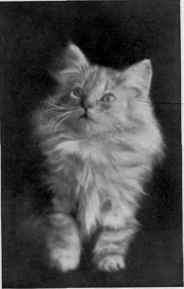Chapter XXXII. The Cat's Place In Nature: Its Ancestry, Classification, Structure, And Distribution
Description
This section is from the book "The Book Of The Cat", by Frances Simpson. Also available from Amazon: The Book Of The Cat.
Chapter XXXII. The Cat's Place In Nature: Its Ancestry, Classification, Structure, And Distribution
AT a very remote period in the history of animal life when the struggle for existence was rife, the carnivorous and pre-daceous animals (to which the existing cat belongs) occupied a position in the scale of creation as important as the one they hold today. We find locked up in the rocks of the tertiary and recent pleistocene formations the bones and teeth of these ancient cats along with those of the animals upon which they lived.

"Holmlea Thistledown." Owned by Mrs. Keep, Sydney, New South Wales.
These ancestors of our cat had a tolerably wide geographical distribution, and they apparently differed considerably in size, as do the different members of the existing cat family. The crested cat (F. crestata) was probably as large as a tiger - more recent remains having a closer affinity to existing cats are found plentifully in caves and in the deeper beds of rivers and lakes almost all over the British Islands.
Probably the most remarkable of these extinct cat-like creatures is the Machoerodus, the skulls of which (Fig. II.), with portions of its skeleton, associated with the bones of other animals, have been found in the cave deposits in Brazil, North and South America, India, Persia, many parts of Europe, as well as in the British Islands - viz. Kent's Cavern, Creswell bone caves, and other places. The skull, which is very typical and cat-like in form, is remarkable for the extraordinary development of the upper canine teeth, which in some species exceed seven inches in length. The Machcerodus was about the size of a lion. The ancestors of our cat were certainly more specialised in parts of their organisation. The nearer we approach the recent forms a greater uniformity in structure prevails, until we get in the existing cat-like group (Felis) probably the most consolidated and uniform of all the generic mammalia.
Family Characteristics
Under the generic title of Felis are included over fifty-one distinct species, of which the lion, tiger, leopard, puma, and our common domesticated cat may be taken as representative. They inhabit every region on the earth's surface, except the extreme northern latitudes, and vary in size from the tiger and lion to the little red-spotted cat of India, which does not exceed fifteen or sixteen inches in length. But it is, as already indicated, very uniform in order as regards structural points. All have well-developed, retractile claws, the only exception being the cheetah, whose claws are only partially retractile; all have five toes on the fore feet, and four on the hind feet ; all the teeth are cusped, or pointed, and specialised for flesh-eating, as well as for aggressive purposes. The incisors in front of the upper and lower jaws are small, the four canines well grown and long, with a cutting edge on the inner side; the molars, or cheek teeth, have one to five cusps, points, or lobes. All the members of the family are digiti-grade (i.e. use only the extremity of the toes in walking); the tympanic bulla, or ear-bone, is large and prominent; the general form of the skull is rounded and broad across the orbits, or eye-sockets (the latter are, with two exceptions, open or incomplete behind); the clavicle, or collar-bone, is reduced to a short, curved, splint-like bone; in many species it is absent.
The stomach is always simple, intestines relatively short, tongue covered with minute spines. In many species the pupil of the eye contracts in one direction only, thus giving it a linear and upright form. The majority of the species are nocturnal; the habits of the genus are very diverse. The lion apparently prefers the drier, sandy areas covered with short, scrubby vegetation; others prefer the dense forests, and live much in the trees. Many species are found at considerable altitudes, the snow leopard being found at 18,000 feet. All the members of the group can swim, and several species (i.e. the fishing cat of India and Southern China) are adepts at catching fish, but immersion is invariably avoided.
The colours of the different members of the genus Felis vary considerably. It may be a uniform, tawny, pale brown, or a grey - as in the lion, puma, eyra. The tiger is striped transversely; the ocelot has bands or rows of more or less fused spots ; the serval and several other species have solid black spots; the leopard, clusters of spots, forming a kind of star; the jaguar has the spots arranged in an open ring. In the clouded leopard of Southern India the markings are composed of irregular groups of lines and spots, merging into the ground colour of the animal's coat. A black variety of the common leopard is occasionally found in a wild state. Albinos, or white forms, are extremely rare in nature, though quite common in the domesticated cat.
Continue to:


